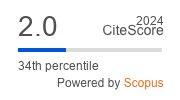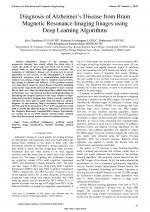| 3/2020 - 7 |
Diagnosis of Alzheimer's Disease from Brain Magnetic Resonance Imaging Images using Deep Learning AlgorithmsSUGANTHE, R. C. |
| Extra paper information in |
| Click to see author's profile in |
| Download PDF |
Author keywords
artificial intelligence, artificial neural network, image classification, machine learning, medical diagnosis
References keywords
disease(23), alzheimer(22), neural(7), prediction(6), learning(6), networks(5), diagnosis(5), deep(5), convolutional(5), techniques(4)
Blue keywords are present in both the references section and the paper title.
About this article
Date of Publication: 2020-08-31
Volume 20, Issue 3, Year 2020, On page(s): 57 - 64
ISSN: 1582-7445, e-ISSN: 1844-7600
Digital Object Identifier: 10.4316/AECE.2020.03007
Web of Science Accession Number: 000564453800007
SCOPUS ID: 85090360650
Abstract
Alzheimer's disease is one amongst the progressive disorder that cruelly affects the brain cells. It causes the death of nerve cells and tissue loss in brain. It usually tends to start slowly and aggravates overtime. The symptoms of Alzheimer's disease vary from person to person depending on the severity of the unhealthiness. It exhibits behavioral symptoms such as communication impairments, memory loss, taking a longer time to complete usual activities, and change in attitude and behavior. If the problem worsens over time, then it cannot be cured. Hence it should be identified at the earlier stage itself and treat the patient to lead a normal life on their own. Deep learning algorithms exhibit marvelous performance over conventional machine learning algorithms in identifying the complex patterns in the large volumes of high-dimensional medical imaging data. Hence, recently significant attention has been paid to apply deep learning for medical diagnosis. In this research, Deep Convolution Neural Network (DCNN) and VGG-16 inspired CNN (VCNN) models have been built to classify the different stages of Alzheimer's Disease from the Magnetic Resonance Imaging(MRI) images. Experiments are carried out on an ADNI dataset and the results obtained show that the proposed models achieved excellent accuracy. |
| References | | | Cited By |
Web of Science® Times Cited: 10 [View]
View record in Web of Science® [View]
View Related Records® [View]
Updated today
SCOPUS® Times Cited: 26
View record in SCOPUS® [Free preview]
View citations in SCOPUS® [Free preview]
[1] Machine learning approach for detection of keratoconus, Shanthi, S, Nirmaladevi, K, Pyingkodi, M, Dharanesh, K, Gowthaman, T, Harsavardan, B, IOP Conference Series: Materials Science and Engineering, ISSN 1757-8981, Issue 1, Volume 1055, 2021.
Digital Object Identifier: 10.1088/1757-899X/1055/1/012112 [CrossRef]
[2] Predictive modeling of Alzheimer's disease progression: Integrating temporal clinical factors and outcomes in time series forecasting, Aqil, K.H., Dumpuri, Prashanth, Ram, Keerthi, Sivaprakasam, Mohanasankar, Intelligence-Based Medicine, ISSN 2666-5212, Issue , 2024.
Digital Object Identifier: 10.1016/j.ibmed.2024.100159 [CrossRef]
[3] Advanced Implementation of Convolutional Neural Networks for Alzheimer's Diseases Diagnosis, Gondalia, Vivek, Popat, Kalpesh, SN Computer Science, ISSN 2661-8907, Issue 4, Volume 6, 2025.
Digital Object Identifier: 10.1007/s42979-025-03851-3 [CrossRef]
[4] Detection of Alzheimer's disease using deep learning models: A systematic literature review, Mohammed, Eqtidar M., Fakhrudeen, Ahmed M., Alani, Omar Younis, Informatics in Medicine Unlocked, ISSN 2352-9148, Issue , 2024.
Digital Object Identifier: 10.1016/j.imu.2024.101551 [CrossRef]
[5] ViT-FusCNN: vision transformer-based weighted fusion of convolution networks for Alzheimer’s disease detection from MRI images with enhanced mother optimization, Mohan, Revathi, Arunachalam, Rajesh, Verma, Neha, Bernatin, Thomas, Signal, Image and Video Processing, ISSN 1863-1703, Issue 7, Volume 19, 2025.
Digital Object Identifier: 10.1007/s11760-025-04094-8 [CrossRef]
[6] A systematic review on recent methods on deep learning for automatic detection of Alzheimer's disease, Chamakuri, Radhakrishna, Janapana, Hyma, Medicine in Novel Technology and Devices, ISSN 2590-0935, Issue , 2025.
Digital Object Identifier: 10.1016/j.medntd.2024.100343 [CrossRef]
[7] MULTI-SLICE MRI CLASSIFICATION FOR ALZHEIMER’S DISEASE DIAGNOSIS WITH DEEP LEARNING, CHEN, YANG, LU, SIYAO, ZHANG, HENG, ZHANG, TENG-TENG, LI, XUEPING, XU, CAIXU, GONG, ZHIPENG, GONG, HAIXIAO, Journal of Mechanics in Medicine and Biology, ISSN 0219-5194, Issue 02, Volume 25, 2025.
Digital Object Identifier: 10.1142/S0219519425400287 [CrossRef]
[8] Brain Image Classification Using Time Frequency Extraction with Histogram Intensity Similarity, Renukadevi, Thangavel, Saraswathi, Kuppusamy, Prabu, P., Venkatachalam, K., Computer Systems Science and Engineering, ISSN 0267-6192, Issue 2, Volume 41, 2022.
Digital Object Identifier: 10.32604/csse.2022.020810 [CrossRef]
[9] Fast Walsh–Hadamard transform and deep learning approach for diagnosing psychiatric diseases from electroencephalography (EEG) signals, Göker, Hanife, Tosun, Mustafa, Neural Computing and Applications, ISSN 0941-0643, Issue 32, Volume 35, 2023.
Digital Object Identifier: 10.1007/s00521-023-08971-6 [CrossRef]
[10] An Evolutionary Federated Learning Approach to Diagnose Alzheimer’s Disease Under Uncertainty, Basnin, Nanziba, Mahmud, Tanjim, Islam, Raihan Ul, Andersson, Karl, Diagnostics, ISSN 2075-4418, Issue 1, Volume 15, 2025.
Digital Object Identifier: 10.3390/diagnostics15010080 [CrossRef]
[11] Multiclass Diagnosis of Alzheimer’s Disease Analysis Using Machine Learning and Deep Learning Techniques, Begum, Afiya Parveen, Selvaraj, Prabha, International Journal of Image and Graphics, ISSN 0219-4678, Issue 03, Volume 24, 2024.
Digital Object Identifier: 10.1142/S0219467824500311 [CrossRef]
[12] Personality Prediction for Online Interview, Nivetha, S.K., Geetha, M., Latha, R.S., Sneha, K., Sobika, S., Yamuna, C., 2022 International Conference on Computer Communication and Informatics (ICCCI), ISBN 978-1-6654-8035-2, 2022.
Digital Object Identifier: 10.1109/ICCCI54379.2022.9740980 [CrossRef]
[13] A Hybrid Approach Based on CNN and Extremely Randomized Trees for the Diagnosis of Alzheimer's Disease Stages from MRI Images, Baccar, Mahdi, Yaddaden, Yacine, Arbane, Mohamed, Cherif, Raef, 2023 IEEE Third International Conference on Signal, Control and Communication (SCC), ISBN 979-8-3503-2639-0, 2023.
Digital Object Identifier: 10.1109/SCC59637.2023.10527649 [CrossRef]
[14] A Hybrid Deep Learning Based Character Identification Model Using CNN, LSTM, And CTC To Recognize Handwritten English Characters And Numerals, Geetha, M., Suganthe, R.C., Nivetha, S.K., Hariprasath, S., Gowtham, S., Deepak, C.S., 2022 International Conference on Computer Communication and Informatics (ICCCI), ISBN 978-1-6654-8035-2, 2022.
Digital Object Identifier: 10.1109/ICCCI54379.2022.9740746 [CrossRef]
[15] Automatic Detection of Tea Leaf Diseases using Deep Convolution Neural Network, Latha, R.S., Sreekanth, G.R., Suganthe, R.C., Rajadevi, R., Karthikeyan, S., Kanivel, S., Inbaraj, B., 2021 International Conference on Computer Communication and Informatics (ICCCI), ISBN 978-1-7281-5875-4, 2021.
Digital Object Identifier: 10.1109/ICCCI50826.2021.9402225 [CrossRef]
[16] Advancements in Artificial Intelligence-Based Alzheimer's Disease Classification Using Magnetic Resonance Imaging: A Comprehensive Review, V, Nisha A, Rajasekaran, M Pallikonda, Rajeev, S K, Wilson, Akhil, Sunil, Salman, M, Soorya, 2024 4th International Conference on Sustainable Expert Systems (ICSES), ISBN 979-8-3315-4036-4, 2024.
Digital Object Identifier: 10.1109/ICSES63445.2024.10763380 [CrossRef]
[17] Deep Learning-based Alzheimer's Detection: A Novel Approach, A N, Saritha, Kattennanavar, Gagandeep, K S, Anagha, S A, Amulya, H M, Akshanth, 2025 International Conference on Computing for Sustainability and Intelligent Future (COMP-SIF), ISBN 979-8-3315-3853-8, 2025.
Digital Object Identifier: 10.1109/COMP-SIF65618.2025.10969870 [CrossRef]
[18] Convolutional Neural Network Based Multi Class Classification Model for Brain Tumor Diagnosis, Suganthe, R.C., Latha, R.S., Geetha, M., Abirami, S.P., Anaya, P., Ganga Sri, A., 2022 International Conference on Computer Communication and Informatics (ICCCI), ISBN 978-1-6654-8035-2, 2022.
Digital Object Identifier: 10.1109/ICCCI54379.2022.9740805 [CrossRef]
[19] A Deep Learning Framework for Football Match Prediction, Nivetha, S.K., Geetha, M., Suganthe, R.C., Prabakaran, R Manoj, Madhuvanan, S, Sameer, A Mohamed, 2022 International Conference on Computer Communication and Informatics (ICCCI), ISBN 978-1-6654-8035-2, 2022.
Digital Object Identifier: 10.1109/ICCCI54379.2022.9740760 [CrossRef]
[20] Performance of CNN Architectures in the Detection of Covid-19 Disease, Renukadevi, N.T., Saraswathi, K., Vigneshwaran, N., Pradeep, V., Arulsanthosh, T.B., 2021 Innovations in Power and Advanced Computing Technologies (i-PACT), ISBN 978-1-6654-2691-6, 2021.
Digital Object Identifier: 10.1109/i-PACT52855.2021.9696954 [CrossRef]
[21] A Time-Series Based Yield Forecasting Model Using Stacked Lstm To Predict The Yield Of Paddy In Cauvery Delta Zone In Tamilnadu, Geetha, M., Suganthe, R.C., Nivetha, S.K., Anju, R., Anuradha, R., Haripriya, J., 2022 First International Conference on Electrical, Electronics, Information and Communication Technologies (ICEEICT), ISBN 978-1-6654-3647-2, 2022.
Digital Object Identifier: 10.1109/ICEEICT53079.2022.9768441 [CrossRef]
[22] Prediction of Alzheimer's Disease using Deep Learning Algorithms, Praveen, P, Srilatha, Koleti, Sathvika, Masabathini, Nishitha, Edulapuram, Nikhil, Madduri, 2023 2nd International Conference on Applied Artificial Intelligence and Computing (ICAAIC), ISBN 978-1-6654-5630-2, 2023.
Digital Object Identifier: 10.1109/ICAAIC56838.2023.10140746 [CrossRef]
[23] Automatic Fruit Detection System using Multilayer Deep Convolution Neural Network, Latha, R.S., Sreekanth, G.R., Suganthe, R.C., Geetha, M., Swathi, N., Vaishnavi, S., Sonasri, P., 2021 International Conference on Computer Communication and Informatics (ICCCI), ISBN 978-1-7281-5875-4, 2021.
Digital Object Identifier: 10.1109/ICCCI50826.2021.9402513 [CrossRef]
Disclaimer: All information displayed above was retrieved by using remote connections to respective databases. For the best user experience, we update all data by using background processes, and use caches in order to reduce the load on the servers we retrieve the information from. As we have no control on the availability of the database servers and sometimes the Internet connectivity may be affected, we do not guarantee the information is correct or complete. For the most accurate data, please always consult the database sites directly. Some external links require authentication or an institutional subscription.
Web of Science® is a registered trademark of Clarivate Analytics, Scopus® is a registered trademark of Elsevier B.V., other product names, company names, brand names, trademarks and logos are the property of their respective owners.
Faculty of Electrical Engineering and Computer Science
Stefan cel Mare University of Suceava, Romania
All rights reserved: Advances in Electrical and Computer Engineering is a registered trademark of the Stefan cel Mare University of Suceava. No part of this publication may be reproduced, stored in a retrieval system, photocopied, recorded or archived, without the written permission from the Editor. When authors submit their papers for publication, they agree that the copyright for their article be transferred to the Faculty of Electrical Engineering and Computer Science, Stefan cel Mare University of Suceava, Romania, if and only if the articles are accepted for publication. The copyright covers the exclusive rights to reproduce and distribute the article, including reprints and translations.
Permission for other use: The copyright owner's consent does not extend to copying for general distribution, for promotion, for creating new works, or for resale. Specific written permission must be obtained from the Editor for such copying. Direct linking to files hosted on this website is strictly prohibited.
Disclaimer: Whilst every effort is made by the publishers and editorial board to see that no inaccurate or misleading data, opinions or statements appear in this journal, they wish to make it clear that all information and opinions formulated in the articles, as well as linguistic accuracy, are the sole responsibility of the author.



